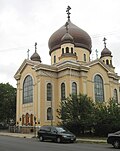Church Image Dates Location City, State Description Church of the Nativity of the Theotokos 1901-05 built 58°0′38″N 152°45′46″W / 58.01056°N 152.76278°W / 58.01056; -152.76278 (Church of the Nativity of the Theotokos, Afognak ) Afognak, Alaska [ 3] Protection of the Theotokos Chapel built 56°56′45″N 154°10′6″W / 56.94583°N 154.16833°W / 56.94583; -154.16833 (Protection of the Theotokos Chapel ) Akhiok, Alaska St. Alexander Nevsky Chapel 1878 founded 54°8′9″N 165°46′39″W / 54.13583°N 165.77750°W / 54.13583; -165.77750 (St. Alexander Nevsky Chapel ) Akutan, Alaska St. John the Baptist Church (Angoon, Alaska) 1929 built 57°30′14″N 134°35′3″W / 57.50389°N 134.58417°W / 57.50389; -134.58417 (St. John the Baptist Church (Angoon, Alaska) ) Angoon, Alaska Holy Resurrection Church (Belkofski, Alaska) 1980 NRHP-listed 55°5′9″N 162°1′9″W / 55.08583°N 162.01917°W / 55.08583; -162.01917 (Holy Resurrection Church ) Belkofski, Alaska St. Sergius Chapel 1891 built 61°34′18″N 159°14′26″W / 61.57167°N 159.24056°W / 61.57167; -159.24056 (St. Sergius Chapel ) Chuathbaluk, Alaska On the Kuskokwim River ; is also known as the "Little Russian Mission" St. Michael the Archangel Church (Cordova, Alaska) 1925 built 60°32′33″N 145°44′16″W / 60.54250°N 145.73778°W / 60.54250; -145.73778 (St. Michael the Archangel Church (Cordova, Alaska) ) Cordova, Alaska Old St. Nicholas Russian Orthodox Church 1972 NRHP-listed Eklutna Village Rd. Eklutna, Alaska St. Nicholas Chapel (Ekuk, Alaska) built Ekuk, Alaska Sts. Sergius and Herman of Valaam Church c.1930 built English Bay, Alaska Nave section once was a dance hall St. Nicholas Chapel (Igiugig, Alaska) 1930 built 59°20′5″N 155°32′27″W / 59.33472°N 155.54083°W / 59.33472; -155.54083 (St. Nicholas Chapel (Igiugig, Alaska) ) Igiugig, Alaska St. Nicholas Russian Orthodox Church (Juneau, Alaska) 1893 built 326 5th St. 58°18′11.65″N 134°24′32.39″W / 58.3032361°N 134.4089972°W / 58.3032361; -134.4089972 (St. Nicholas Russian Orthodox Church (Juneau, Alaska) ) Juneau, Alaska Ascension of Our Lord Chapel 1888 built 57°34′8″N 154°27′19″W / 57.56889°N 154.45528°W / 57.56889; -154.45528 (Ascension of Our Lord Chapel ) Karluk, Alaska Holy Assumption of the Virgin Mary Church 1895 built Mission and Overland Streets 60°33′10.7″N 151°16′3.4″W / 60.552972°N 151.267611°W / 60.552972; -151.267611 (Holy Assumption of the Virgin Mary Church ) Kenai, Alaska [ 4] Holy Resurrection Church (Kodiak, Alaska) 1796 founded Mission Road and Kashevaroff Street 57°47′18.4″N 152°24′10″W / 57.788444°N 152.40278°W / 57.788444; -152.40278 (Holy Resurrection Church (Kodiak, Alaska) ) Kodiak, Alaska St. Nicholas Russian Orthodox Church (Kwethluk, Alaska) built Lower Kuskokim R. Kwethluk, Alaska Sts. Constantine and Helen Chapel built Lime Village, Alaska St. Seraphim Chapel 1800s built 61°30′45″N 160°21′29″W / 61.51250°N 160.35806°W / 61.51250; -160.35806 (St. Seraphim Chapel ) Lower Kalskag, Alaska St. John the Baptist Chapel (Naknek, Alaska) built Naknek, Alaska St. Jacob's Church (Napaskiak, Alaska) 1980 NRHP-listed 60°42′30″N 161°45′47″W / 60.70833°N 161.76306°W / 60.70833; -161.76306 (St. Jacob's Church (Napaskiak, Alaska) ) Napaskiak, Alaska Presentation of Our Lord Chapel before 1914 founded 62°58′3″N 154°9′42″W / 62.96750°N 154.16167°W / 62.96750; -154.16167 (Presentation of Our Lord Chapel ) Nikolai, Alaska St. Nicholas Church (Nikolski, Alaska) 1930 built 52°56′17″N 168°52′4″W / 52.93806°N 168.86778°W / 52.93806; -168.86778 (St. Nicholas Church (Nikolski, Alaska) ) Nikolski, Alaska Holy Transfiguration of Our Lord Chapel 1901 built Sterling Highway 60°3′1″N 151°39′53″W / 60.05028°N 151.66472°W / 60.05028; -151.66472 (Holy Transfiguration of Our Lord Chapel ) Ninilchik, Alaska St. Nicholas Chapel (Nondalton, Alaska) 1920s built 2nd Avenue 59°58′24″N 154°50′55″W / 59.97333°N 154.84861°W / 59.97333; -154.84861 (St. Nicholas Chapel (Nondalton, Alaska) ) Nondalton, Alaska Transfiguration of Our Lord Chapel built Nushagak, Alaska Nativity of Our Lord Chapel 1906 built 57°55′26″N 152°29′54″W / 57.92389°N 152.49833°W / 57.92389; -152.49833 (Nativity of Our Lord Chapel ) Ouzinkie, Alaska Sts. Sergius and Herman of Valaam Chapel 1898 built Spruce Island, Mok's Lagoon 59°21′22″N 151°55′13″W / 59.35611°N 151.92028°W / 59.35611; -151.92028 (Sts. Sergius and Herman of Valaam Chapel ) Ouzinkie, Alaska St. Nicholas Chapel (Pedro Bay, Alaska) 1890 built 59°47′7″N 154°6′9″W / 59.78528°N 154.10250°W / 59.78528; -154.10250 (St. Nicholas Chapel (Pedro Bay, Alaska) ) Pedro Bay, Alaska St. John the Theologian Church c.1915 built 55°54′45″N 159°8′35″W / 55.91250°N 159.14306°W / 55.91250; -159.14306 (St. John the Theologian Church ) Perryville, Alaska St. Nicholas Church (Pilot Point, Alaska) 1980 NRHP-listed 56°54′52″N 157°36′5″W / 56.91444°N 157.60139°W / 56.91444; -157.60139 (St. Nicholas Church (Pilot Point, Alaska) ) Pilot Point, Alaska St. George the Great Martyr Orthodox Church 1935 built St. George Island 56°33′6″N 169°33′5″W / 56.55167°N 169.55139°W / 56.55167; -169.55139 (St. George the Great Martyr Orthodox Church ) St. George, Alaska Sts. Peter and Paul Church (St. Paul Island, Alaska) 1907 built 57°7′27″N 170°16′57″W / 57.12417°N 170.28250°W / 57.12417; -170.28250 (Sts. Peter and Paul Church (St. Paul Island, Alaska) ) St. Paul Island, Alaska St. Nicholas Chapel (Sand Point, Alaska) 1936 built 55°15′16″N 160°29′57″W / 55.25444°N 160.49917°W / 55.25444; -160.49917 (St. Nicholas Chapel (Sand Point, Alaska) ) Sand Point, Alaska St. Nicholas Chapel (Seldovia, Alaska) 1980 NRHP-listed 59°25′49″N 151°42′40″W / 59.43028°N 151.71111°W / 59.43028; -151.71111 (St. Nicholas Chapel (Seldovia, Alaska) ) Seldovia, Alaska St. Michael's Cathedral (Sitka, Alaska) 1848 built Lincoln and Maksoutoff District 57°03′00″N 135°20′06″W / 57.0501°N 135.3351°W / 57.0501; -135.3351 (St. Michael's Cathedral ) Sitka, Alaska Designated a U.S. National Historic Landmark in 1962 Elevation of Holy Cross Church 1980 NRHP-listed 58°42′56″N 157°0′9″W / 58.71556°N 157.00250°W / 58.71556; -157.00250 (Elevation of Holy Cross Church ) South Naknek, Alaska Church of the Holy Ascension 1826 built 53°52′32″N 166°32′10″W / 53.87556°N 166.53611°W / 53.87556; -166.53611 (Church of the Holy Ascension ) Unalaska, Alaska Designated as a U.S. National Historic Landmark 








































